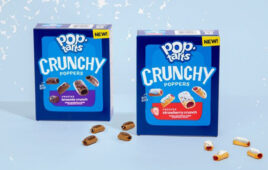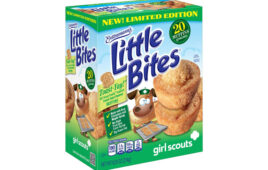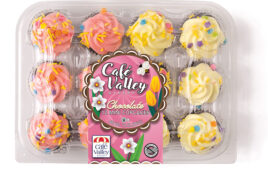Changing demand for snacks is reflected in c-store offerings.
By Howard Riell, Associate Editor
Americans love chips and other salty snacks, but purchasing preferences seem to be changing at a quicker pace than in the past. Convenience stores should factor in changing tastes when planning store sets.
The growth in sales of salty snacks in the U.S. has been steady over the last five years, with year-over-year growth each year always in the small range “between 3.1% and 4.4%,” Packaged Facts recently reported.
The research firm forecasts sales of salty snacks will maintain the same moderate growth they have experienced in the last couple of years through the forecast period to 2020. “Sales growth per year will remain around the same through the forecast period to 2020, with sales in 2020 reaching $27.0 billion.”
Salty snacks rose a healthy 7.43%, to nearly $5.4 billion, according to Information Resources Inc. (IRI)’s convenience store scanning data for the 52 weeks ending Feb. 25, 2018. Potato chips account for $1.7 billion, rising by 7.41% during the period. Leading brands include Frito-Lay, Kellogg, Herr’s, Utz and private label. Pretzels notched just under $239 million in sales, a 2.61% increase. Ready-to-eat popcorn/caramel corn saw sales rose by 6.08% to $231 million.
Pork rind sales jumped 5.13%, to slightly more than $204 million.
SELLING POINTS
“There are three key elements to selling more chips and salty snacks,” said Steven Montgomery, president of b2b Solutions LLC in Lake Forest, Ill. “The first is location. To determine the best location, retailers must know their customers’ purchase paths. The thirst occasion is what drives most customers to shop a c-store. Stopping a customer on their way to their initial destination inside a store is very difficult. It is far easier to stop them once they have made that purchase.”
Montgomery explained c-stores have two principle areas for satisfying the thirst occasion: the walk-in cooler and the fountain area, which are two areas for realizing more snack sales. “Retailers need to determine the best location to interrupt the consumer from these back to the register for that add-on purchase. It may not be possible to do both with a single salty snack location. This can be addressed by the use of endcaps or free-standing displays.”
Product selection is the second driving force, said Montgomery. Retailers should carefully evaluate their SKUs to determine what is selling and what isn’t.
“While there are items that sell in every c-store, there are also many that do not. By first looking at what the customer is currently buying the retailer can determine what potential items they should add to the mix,” said Montgomery. “This may help them determine what items are more likely to sell to their fountain versus bottle and can buyers. Research has also shown the free-standing displays can increase the sales of salty snacks. These are often temporary displays featuring a promotional item.”
HEALTHY RETURNS
Americans increasingly want healthy everything, including salty snacks. That trend is taking shape in the convenience channel.
“I feel like traditional salty snacks are coming down, mainly because most people are starting to watch their health now,” said Kumar Assandas, a 7-Eleven Inc. franchisee in Henderson, Nev. “Everybody is being more fitness-conscious and active, so things like snap peas and other alternatives are starting to pick up a little more.”
That said, Assandas has experienced sales of healthier chip and salty snack alternatives begin to rise at his stores.
“They are doing better than the traditional type.”
Indeed, for the long term, Assandas said he sees traditional chips continuing to lose favor.
Given that view, his advice to colleagues is logical. “Expand your assortment and bring in as many healthy products, as many SKUs that are directed toward fitness, as possible in that salt section.”
TRACKING DAYPARTS
Which snacks consumers pluck from shelves can have as much to do with the time of day as the merits of the products themselves.
Blaine Becker, senior director of marketing for The Hartman Group, Inc. in Bellevue, Wash., said his firm has identified the times of day in which consumers are reaching for salty snacks. For example, during the afternoon, 13% of consumers who snack choose salty snacks like chips and popcorn; 11% choose crackers. After dinner and during evening snacking occasions, 12% consume salty snacks.
Hartman Group research has also found that snacking tends to increase as the day progresses, when there is a greater desire to indulge rather than exercise restraint. Chips and salty snacks are preferred on afternoon snacking occasions and less so on after dinner and evening hours.
SELLING MORE
Retailers must remain vigilant for clues that can help them boost salty snack sales.
John Lutz, senior category manager for Pilot Travel Centers LLC, in Knoxville, Tenn., said that larger pack sizes and retail sizes continue to be a strong trend.
“Convenience stores are moving into pack types that would normally only be in other channels such as grocery and drug. Regional offerings are important to have from chips to meat snacks.”
Limited-time offers help to keep the category interesting, including seasonal flavors, Lutz suggested. “A diverse product portfolio that delivers choice is important to satisfy the needs of the guest.”
According to Chicago-based retail consultant Nicole Leinbach Reyhle, c-store operators should merchandise these impulse buys near their cash wrap, as well as cross-merchandise them throughout their stores to increase the opportunity for sell through.
Snacks Grow Diverse
According to McLane, 62% of customers eat salty snacks as a stress reliever, compared to 16% a year ago, and a third of customers eat salty snacks away from home, with 26% eating them at work. Ninety-four percent of Americans purchase salty snacks, and 13% replace meals with them.
Four of five U.S. consumers agree that salty snacks can be healthy and tasty.
Brands should identify with the “better for you” interests of consumers and remain transparent in the ingredients they are adding and removing from snacks.
Potato chips are the leader with 32% of category sales, followed by tortilla chips and other salted snacks. Product innovation is helping drive the momentum in the salty snack category in convenience. According to Nielsen research, customers are looking for familiar flavors with new twists, and nontraditional ingredients are growing in appeal.
New chip flavors now being introduced in the market combine traditional salty tastes with flavors of different dining experiences, including creamy garlic Caesar, milk chocolate, crushed red pepper, ketchup, wasabi ginger, biscuits and gravy, cinnamon with sugar and chicken with waffles.




